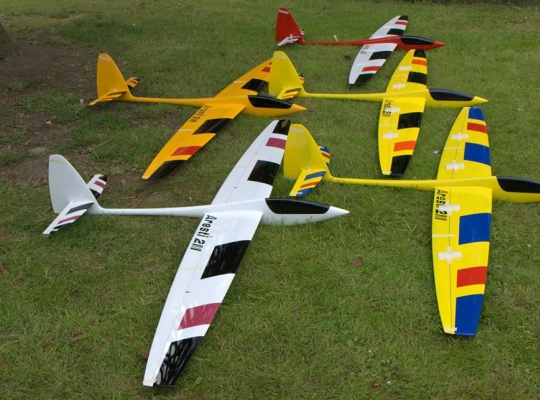
Aeroic Aresti 80 2 Metre Aerobatic Glider
The Aeroteam Aresti 80 (2.0M)
The Aresti 80; a high performance Aerobatic sailplane from successful designer Dr. James Hammond.
Like its big brother, the new thoroughbred “Big Air” Aresti 108, the smaller 2M version has exceeded expectations throughout the entire design and flight envelope.
The Aresti 80 is light so it will fly in almost anything and with its large ballast capacity and responsive reflex section, of course it can handle most situations very well.
Now here’s how:
Overall design:
James set out a set of strict design goals, based on the work the plane has to do; then he drew up a sketch that will fulfill those goals. Then he curved and tweaked it – always keeping a good eye on the performance requirements. It is probably a rather long-winded approach but it works, giving nice looks but with no sacrifice to performance.
The Aresti 80 is easy to fly. It has an optimized wing plan form and completely new wind tunnel tested aerofoils. The layout of the wings and fuselage has ample room to allow plenty of ballast in the fuse and optional ballast in the wings too.
There is a great truism: “If it looks right, it will fly right…” this is backed up 100% with the Aresti series.
Aerofoils:
Originally designed as F3X type tailplane aerofoils the sections used on the Aresti 80 were refined to provide for maximum control response with minimum deflection, and therefore drag; so the trade off was the infinitesimal increase in drag offset by the increased control response for less deflection.
At 10%, the fully symmetrical double cusped section is thick enough to give good aerobatic response yes still carry a good ballast load and work well in sketchy air.
Wings:
The optimized sections will let you go from gut busting aerobatics, through big air, graceful maneuvers down to really slow landing speeds with the flaps down. Large ailerons, large flaps and a semi elliptical wing plan form each add to the overall performance of the sailplane.
Needless to say the wings are available in glass or full carbon lay-up options. Horns are factory fitted with well thought out geometry to allow flush servo installation using almost any servos, making a huge range of servos possible. Using conventional linkages you can get a clean, practical and most importantly serviceable wing installation optimized to use full servo travel to give high torque and low slop.
Ballast tubes in the wing add to the flexibility.
Aeroteam Sine Wave Spar:
Used in several military aircraft, the Sine Wave Spar has been adapted for the first time to make up the heart of a model sailplane wing, and has frankly amazed us with its low weight, and ultra high strength. Unlike a conventional spar the Sine Wave Spar adds terrific torsional strength and yet actually weighs considerably less than the older non-optimized spar.
Now to be used in all Aeroteam sailplanes, the Sine Wave Spar is a lighter and far stronger upgrade that raises the technology level yet another notch and could be a game changer in model sailplane technology.
Fuselage:
The beautifully contoured fuse is deep, and balanced front to back to give the side area required for some aerobatic maneuvers. Its strong, light, and stiff with Carbon/Kevlar. Electronics area is 2.4 GHz friendly with access to the radio and ballast through a conventional slide-on hatch type canopy. The long nose area provides plenty of space to easily balance the model without resorting to shoehorning lead in every nook and cranny.
Snakes or rear mounted direct servos can be used for Rudder/Elevator control. These are all positioned to take the ‘head scratching’ out of installing the radio gear and to allow the use of standard 19/20mm round ballast slugs, 8 of them if you need them, which added to the optional ballast in the wings allows more than 1.5kg capability!
The rudder is designed large enough to be effective for both aerobatics and slow landing speeds. Wing stub fairings with location dowel holes finish the fuselage with green Multiplex connectors to connect the electronics pre routed.
An added advantage is that it’s extremely easy to convert to electric.
Tailplane:
At 10%, the tail sailplane section is thicker than is the norm but the infinitesimal increase in drag is easily offset by the increased control response for less deflection.
To increase the efficiency, pitch control is accomplished by using an elevator. The elevator is driven by either an optional ball raced bell crank from a servo in the fuse, or a servo can be placed in a hatch through the fin to give solid elevator control. The tails remain removable for convenient transport or storage.
Joiner:
Like all of the Aeroteam airframes, the Aresti 80 has a large joiner. Massive is the only way to describe this part. It’s just over 35 x 12mm and can handle light acro DS.
Production:
The Aresti series has been designed with far greater capability potential than any aerobatic slope models that we know of, but also for simplicity. This approach makes the installation straightforward and practical, leads to a sailplane that is a snip to fit out, and flies like the true thoroughbred it is.
Technical specs:
Span: 2.0M (80”)
Length: 1.225M (48”)
Wing area: 38dm (589 Sq”)
Wing aerofoil: JH10SYM
Tailplane aerofoil: JH10SYM
Controls: Ailerons, Flaps, Elevator, Rudder
Servos: Mini’s in the wings up to full sized for the fuselage

 Add to
Wishlist
Add to
Wishlist




